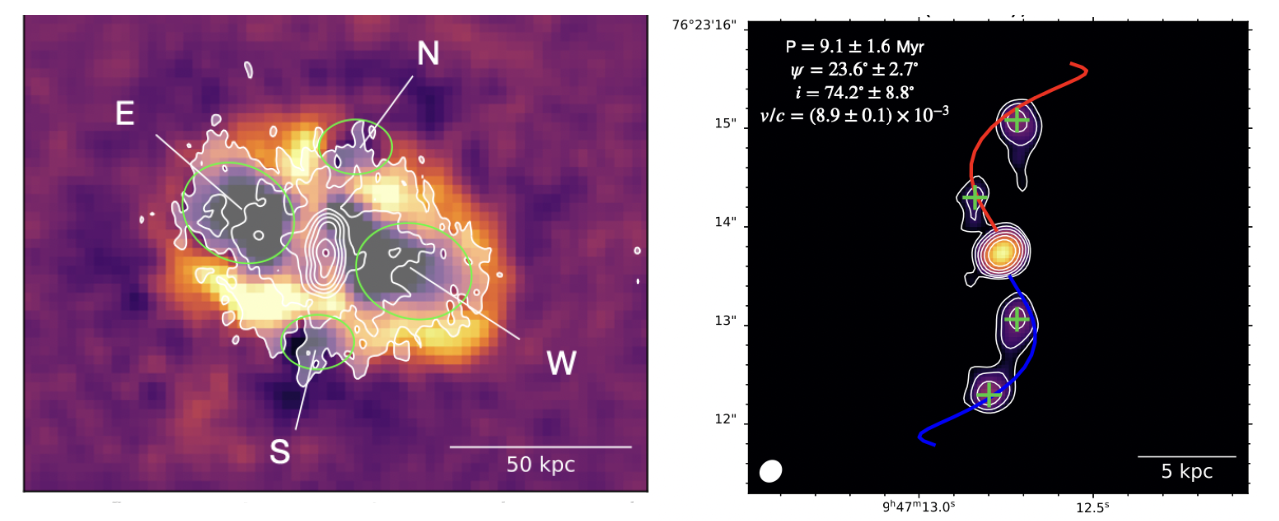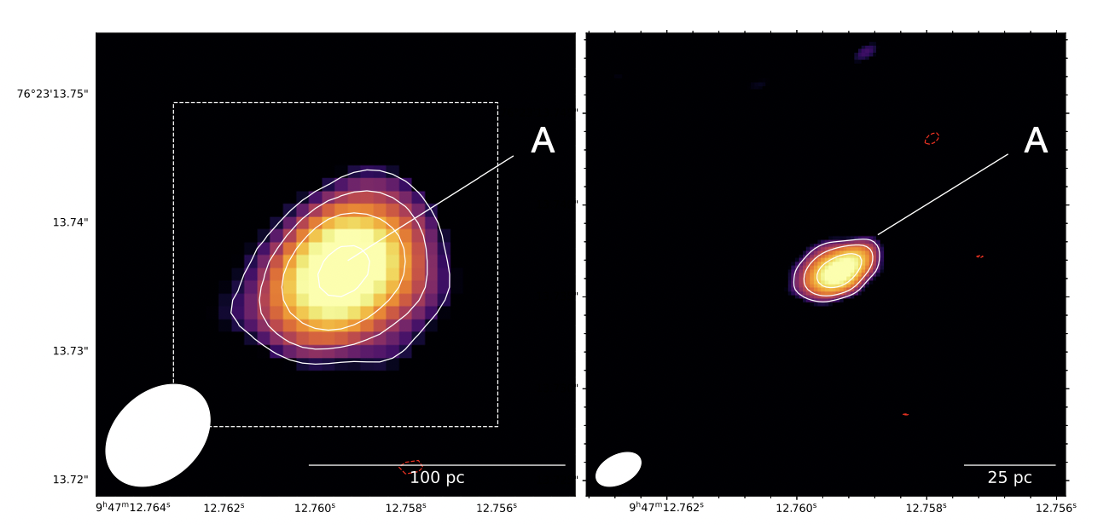
A JVLA, LOFAR, e-Merlin, VLBA and EVN study of RBS 797: can binary supermassive black holes explain the outburst history of the central radio galaxy?
Francesco Ubertosi
Supermassive black holes (SMBHs) can experience multiple phases of activity as Active Galactic Nuclei (AGN) over time. There are cases in which the SMBH drives a new pair of jets before the previous lobes completely fade, which can result in multiple pairs of radio lobes around a single AGN (e.g., Saikia & Jamrozy 2009). A variety of radio sources have so far questioned the idea that SMBH-driven jets are always stable, straight, linear outflows. Several radio galaxies show multiple misaligned radio lobes or twisting relativistic jets, even though it is still unclear which mechanism is responsible for the changes in jet axis (e.g., Krause et al. 2019). For instance, binary SMBHs can cause jet precession in the active SMBH due to the gravitational interaction of the binary; alternatively, a merger of binary SMBHs may lead to a spin-flip of the merged, more massive SMBH, which would drive jets in a perpendicular direction with respect to the previous outburst. A significant challenge in testing these scenarios arises from the vast range of spatial scales involved, spanning from a few pc to tens of kpc.

Figure 1, Left: Residual Chandra image of the galaxy cluster RBS 797. The white contours tracing the perpendicular radio lobes of the central AGN are from the JVLA 3 GHz data (starting at 5 times the rms noise of 5.5 mJy/beam and increasing by a factor of 2). The X-ray cavities previously discovered in Ubertosi et al. (2021) are shown with green ellipses. Right: Jet precession in RBS 797. Precession model of Hjellming & Johnston (1981) fitted to the radio images of the kpc-scale jets in RBS 797. White contours start at 5 times the rms noise (3 mJy/beam) and increase by a factor of 2. The red line represents the receding jet path, and the blue line represents the approaching jet path. The location of the green crosses corresponds to the position of the observed hotspots, while their extent represents the resolution of the radio observation (the beam is shown in the bottom left corner). The obtained precession parameters are reported in the top left corner.
Thanks to the combination of new, sensitive radio observations at high spatial resolution we have tested the above arguments for the central radio galaxy of the galaxy cluster RBS 797. This multifaceted radio galaxy was previously known to show several episodes of jet activity in multiple directions, which had excavated perpendicular and equidistant pairs of bubbles (or ‘cavities’) in the surrounding intracluster medium.
In our recent work, we presented a multi-frequency (144 MHz – 9 GHz) and multi-scale (5 pc – 50 kpc) investigation of the central radio galaxy in RBS 797, by means of JVLA, LOFAR (with international stations), e-Merlin, VLBA and EVN data. The JVLA and LOFAR data confirmed the co-spatiality of the radio lobes with the four perpendicular cavities (see Fig. 1 left); the radiative ages of the E-W lobes (31.4±6.6 Myr) and of the N-S lobes (32.1±9.9 Myr) support a coeval origin of the perpendicular outbursts. Based on the analysis of the inner N-S jets (on scales of ≤ 10 kpc), we (a) confirm the S-shaped jet morphology; (b) show the presence of two hotspots per jet with a similar spectral index; (c) estimate the age of the twisting N-S jets to be less than ∼ 8 Myr. We determine that jet precession, with period ∼9 Myr, half-opening angle ∼24°, and jet advance speed ∼0.01c can describe the properties of the N-S jets (see Fig. 1 right). These findings can be explained by several scenarios, all of which include binary supermassive black holes. If the precession was caused by the mutual gravitational perturbation of binary black holes, the above precession period of 9 Myr would translate into an upper limit for the binary separation of less than 0.6 pc.

Figure 2: EVN images at 1.6GHz and 5GHz. The beam sizes are 9.1x6.7 mas at 1.6GHz; and 2.6x1.6 mas at 5GHz. In each panel the beam is shown in the bottom left corner and contours start at 5 times the rms noise (30µJy/beam and 15µJy/beam respectively) and increase by a factor of 2; the first negative contour at -3 times the rms noise is drawn in dashed red. The white dashed square shows the extent of the images at 5GHz. These images reveal a single compact component on scales down to a few parsecs.
Critical to this point, our study comprised Very Long Baseline Interferometry data from the VLBA and the EVN facilities. The EVN observations at 1.6 GHz and 5 GHz performed in the spring of 2014 revealed a single compact active core at the heart of RBS 797. This rules out the possibility that binary active black holes are present on scales between a few tens and a few hundreds of pc. However, the EVN data are still consistent with the binary interpretation, since the predicted separation of the SMBHs (below 0.6 pc) is an order of magnitude smaller than the spatial resolution of the VLBI data (about 5 pc).
Our study points out the intrinsic difficulty in confirming the presence of binary SMBHs even when large radio datasets are available. Additionally, our study highlights the critical need 1. for high resolution observations that are also sensitive to large scale, diffuse radio emission (such as the LOFAR data with international stations, or the JVLA data), 2. for sub-arcsecond mapping of the details of jets (with the e-Merlin data), and 3. for the critical coverage at parsec scale resolution (with the VLBA and the EVN). This is required to connect the fine structure of the jets in radio galaxies with the complex geometry of their large expanding lobes.
References:
Hjellming, R. M. & Johnston, K. J. 1981, ApJ, 246, L141
Krause, M. G. H., Shabala, S. S., Hardcastle, M. J., et al. 2019, MNRAS, 482, 240
Saikia, D. J. & Jamrozy, M. 2009, Bulletin of the Astronomical Society of India, 37, 63
Ubertosi, F., Gitti, M., Brighenti, F., et al. 2021, ApJ, 923, L25
More information: Published in Ubertosi et al. 2024, arXiv:2405.08079 (accepted for publication in Astronomy & Astrophysics).
Authors:
F. Ubertosi, M. Giroletti, M. Gitti, N. Biava, E. De Rubeis, A. Bonafede, L. Feretti, M. Bondi, L. Bruno, E. Liuzzo, A. Ignesti, G. Brunetti.
Contact: francesco.ubertosi2@unibo.it